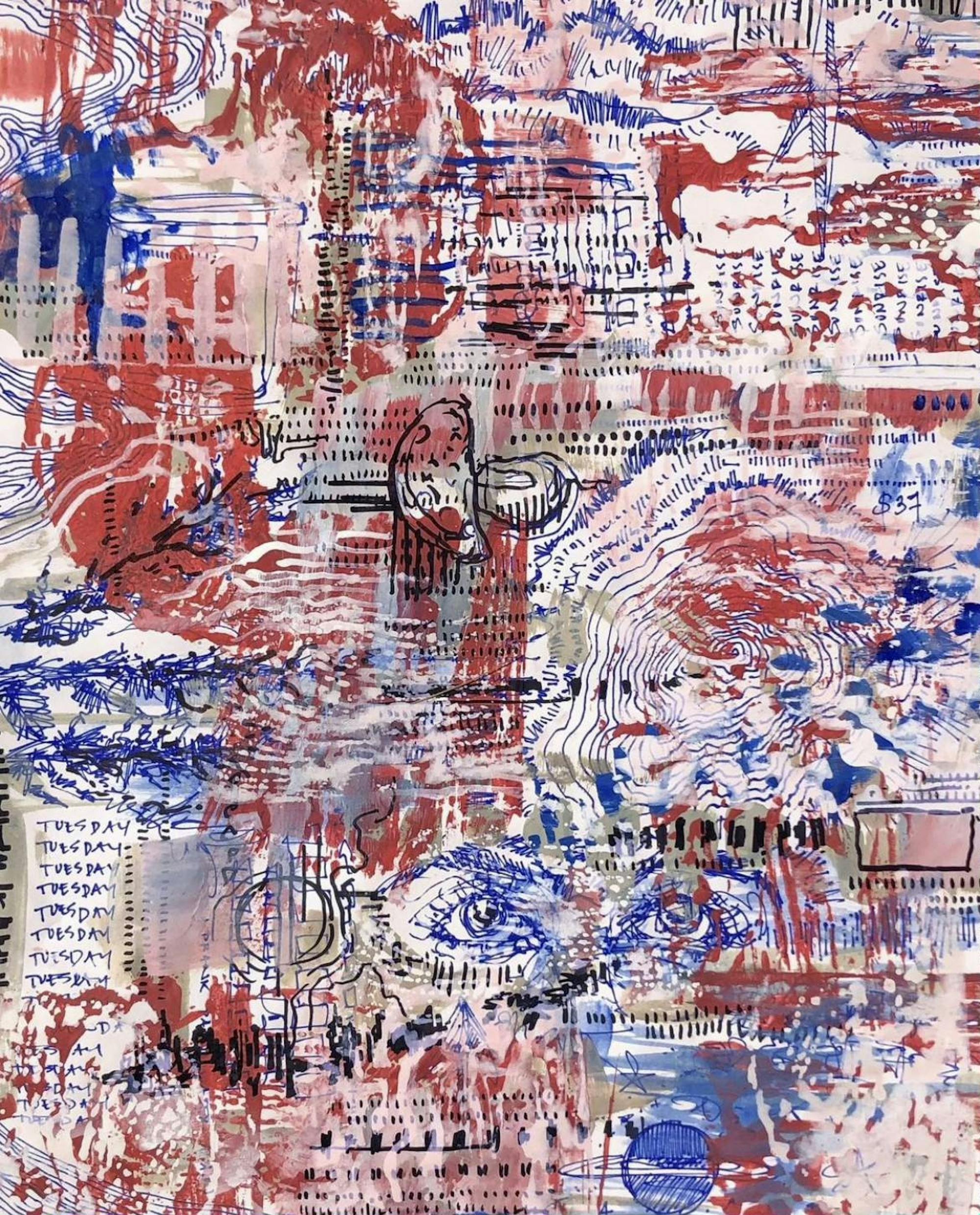Alice Crow ’22 produces abstract works that deal with themes of the subconscious and nature. Double majoring in studio art and history, Crow currently works as a campus engagement intern at the Hood Museum of Art where she helps connect students to the museum and curate an upcoming exhibit.
Though always passionate about art, Crow began to seriously consider majoring in studio art during her freshman spring at Dartmouth. After taking a few art classes, Crow’s focus shifted from representational work — a more traditional style of art that focuses on accurate depiction of the real world — to the abstract as she moved away from portraiture and towards multimedia, painted pieces.
“When I started painting on my own, and not just for class assignments, [my work] quickly became abstract,” Crow said. “I do love making representational work, but if I just let go and see what I paint, it’s abstract. It almost feels out of control in that way that I can’t slow myself down enough to make something representational.”
In her work, Crow builds bright layers using a variety of mediums: acrylic paint, drawings, lettering and collages with photographs. She aims to produce a dynamic relationship among these layers by including both “organic” and “industrial” elements in her pieces.
“I would describe my work as using overlapping layers of organic and industrial forms,” Crow said. “There’s rhythmic or pattern based processes as well as more organic and uncontrolled processes. I combine those two processes to create some sort of competition.”

"Untitled" by Alice Crow, acrylic on canvas.
Crow added that her pieces often incorporate natural forms that resemble water features, geological shapes and tree rings, though the features are open to viewer interpretation.
Crow’s longtime friend, roommate and fellow studio art major Ronnie Ahlborn ’22 said that the methods involved in Crow’s art reflect her development as an artist.
“Everything that she’s been doing up to this year has been building a new layer in her work,” Ahlborn said. “[There are] pen drawings that she used to make in high school and freshman year, and those really come through with her current pieces. Her writing used to be a lot more prominent in her work. Now, the writing is still very present but in a different way. It’s not as literal, but it’s there, and the emotion behind it is there.”
Last fall, Crow worked on an independent study with studio art professor Thomas Ferrara. Ferrara praised the sense of structure and rhythm in Crow’s art.
“She’s a great draftsman, and her drawing is phenomenal,” Ferrara said. “Her paintings have a really strong sense of structure as a result of that, but also a really strong sense of rhythm that moves the eye around.”
During this independent study, Crow concentrated on moving to larger canvases, forcing her to convert smaller sketches to a greater scale.
Last fall, in addition to her independent study, Crow designed an upcoming exhibit at the Hood called “Transcendent Landscapes: Abstracting Nature.” Through researching for the exhibit, which included pieces from female abstract expressionists, Crow discovered that the central theme of the exhibit has influenced her own work.
“I’m curating an exhibit that looks at abstract art of landscapes and how artists use that to convey spirituality, either within themselves or in their connection to the landscapes in a spiritual or metaphysical sense,” Crow said. “In my own experience, art has had a role in communicating my mind or my emotions, and it does feel like tapping into the subconscious, and it can be somewhat spiritual.”

"Untitled" by Alice Crow, acrylic and charcoal.
After curating this exhibit which will be on display in early March, Crow said she began to think about the concept of automatism in art — essentially, when the hand, rather than the mind, guides a painting. Through abandoning a more calculated approach, Crow can more freely and truthfully convey her subconscious.
“I don’t ever approach pieces with a super clear cut concept … The process itself is sort of the subject,” Crow said. “I often end up creating abstract landscapes or an abstract ‘mindscape.’ In other words, because I don’t plan out my work, it turns out to be a landscape of my mind.”
Crow draws inspiration for expressing her mental landscape from the natural world.
“My work is a synthesis of what I’m taking in around me,” Crow said. “I find the most beauty in nature. That’s my most obvious source of color and light and composition … and the world around me does happen to be very natural and rural.”
During the pandemic while at home in New Hampshire, Crow was able to work more intensely on her work, which helped her realize her desire to pursue a career as an artist. Looking forward, she hopes to pursue a Masters in Fine arts a couple years after graduation
“I always had a sense that, by the end of my life, I would be an artist, but I initially expected to do something else first and then come back to it,” Crow said. “During the pandemic, it just became clearer and clearer … that I could make sense out of my life through making art.”




